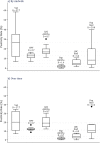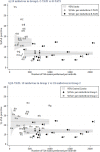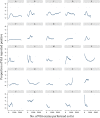Visual inspection after acetic acid (VIA) is highly heterogeneous in primary cervical screening in Amazonian Peru
- PMID: 25635965
- PMCID: PMC4312028
- DOI: 10.1371/journal.pone.0115355
Visual inspection after acetic acid (VIA) is highly heterogeneous in primary cervical screening in Amazonian Peru
Abstract
Background: Conventional cytology (Pap) and visual inspection after the application of acetic acid (VIA) are currently used in primary screening in Peru. Studies suggest that the quality of VIA is highly variable. Over 36 000 women were screened with Pap and VIA in the TATI (Tamizaje y Tratamiento Inmediato de Lesiones Cervico-uterinas) project conducted in Amazonian Peru. Within a nested study to compare several screening techniques (C-TATI), a total of 5435 women were additionally screened with liquid-based cytology (LBC) and high-risk human papillomavirus testing (HR-HPV). We investigate the variation of positivity rates of VIA, Pap, LBC and HR-HPV in C-TATI and of VIA in the full TATI intervention.
Methods: At the screening visit, midwives collected three cervical samples for Pap, LBC and HC2 before performing VIA. The dispersion factor "D" (D = Pearson chi-square value/degrees-of-freedom) was used to measure the variability of tests results. Within C-TATI, the variability of positivity rates of VIA, Pap, LBC and HR-HPV was also graphically assessed with box- and scatter plots by midwife and month of screening. Funnel plots and smoothed scatter plots were used to correlate the variation of VIA by the number of examinations performed by each midwife over the full TATI intervention.
Results: Consistently over TATI, VIA results were highly variable, independently of the examiner, the time when the test was performed and the number of tests the examiner performed (D>6, p-values<0.001). In C-TATI, VIA results varied the most while those of HR-HPV varied the least (Ds>25, p-values<0.001 for VIA, Ds<1.6, p-values>0.05 for HR-HPV). No evidence for correlation between the number of VIAs done per midwife and the variability of VIA results was observed.
Conclusion: The lack of over-dispersion for HR-HPV detection suggests that the variable VIA results do not reflect true variation in underlying disease, but a lack of consistency in human judgement.
Conflict of interest statement
Figures




References
-
- Ferlay J, Soerjomataram I, Ervik M, Dikshit R, Eser R, et al. (2013) GLOBOCAN 2012 v1.0, Cancer Incidence and Mortality Worldwide: IARC CancerBase No.11 [Internet]. Lyon, France: International Agency for Research on Cancer; http://globocan.iarc.fr. Accessed on 13 May 2014.
-
- (2005) IARC Handbooks of Cancer Prevention Vol. 10 Cervix Cancer Screening.
Publication types
MeSH terms
Substances
Grants and funding
LinkOut - more resources
Full Text Sources
Other Literature Sources
Research Materials

